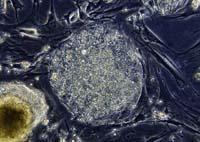A new return in stem cell research

More than half of the in vitro fertilized eggs do not develop until the blastozist state, stop fragmenting and do not progress. The Príncipe Felipe Research Center of Valencia has used these unviable eggs to obtain stem cells. This may overcome laws that prevent the use of embryos in stem cell research.
The simplest way to obtain stem cells is the use of embryos, which must be in the early stages of development, since then the cells begin to separate and develop and lose the ability to supply any tissue (they are not totipotent). However, in many countries the use of embryos is prohibited, in the conviction that it violates the right to life. Frozen embryos that have been stored after in vitro fertilization cannot be used, although they will probably not be implanted in another's uterus.
To overcome these obstacles, researchers are obliged to invent circles. The step taken in Valencia is an opportunity, but it is not very effective, since most of the cells of these unviable embryos have defects, so they are not useful for research. In any case, if researchers were not required to tackle these ethical obstacles, stem cell research would be easier.
Buletina
Bidali zure helbide elektronikoa eta jaso asteroko buletina zure sarrera-ontzian











